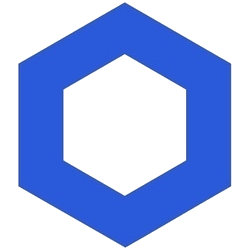| TOKEN | TYPE | USD | WETH | USDT | PRICE | MAKER | TXN |
|---|---|---|---|---|---|---|---|
LINK.e / WAVAX Chainlink Token
TXNS
35
VOLUME
3.777k
MAKERS
29
buys
18
sells
17
buy vol
$ 1.762k
sell vol
$ 2.015k
buyers
17
sellers
12
Security Audit
Taxes:
Honeypot
No
Cannot buy
No
Cannot sell all
No
Self-destruct
No
Mintable
Yes
Freezable
No
Proxy/Upgradeable
No
Blacklist
No
Whitelist-only
No
Anti-whale
No
Anti-whale modifiable
No
Owner can change balance
No
External calls
No
Slippage modifiable
No
Personal slippage
No
Trading cooldown
No
Open source
Yes
Trusted list
Yes
Listed on DEX
Yes
Ownership
Owner
-
0%
Creator
0x50ff…ea04
0%
LP holders: 43
LP total supply: 123.75k
Community Reports
There are currently 0 reports that this pool is suspicious
Scan
LINK.e to WAVAX Converter
LINK.e
0.823914
WAVAX
More

What is Chainlink? Chainlink is the industry-standard oracle platform bringing the capital markets onchain and powering the majority of decentralized finance (DeFi). Chainlink stands to benefit the most from emerging blockchain-industry trends, such as stablecoin adoption, real-world asset tokenization, and institutional adoption of blockchain technology. Chainlink is powered by the LINK token, which is used to pay for platform services and secure the network’s proper functioning. Chainlink leverages a novel fee model where offchain and onchain revenue from enterprise adoption is converted to LINK tokens and stored in a strategic Chainlink Reserve. Chainlink is at the forefront of financial innovation and the global tokenization trend. Traditional financial institutions and infrastructures, such as Swift, DTCC, Euroclear, J.P. Morgan, Mastercard, Central Bank of Brazil, UBS, SBI, Fidelity International, ANZ, and many others are adopting Chainlink as fundamental infrastructure as they move toward tokenizing trillions onchain. Demand for Chainlink has already generated hundreds of millions of dollars in revenue across a variety of traditional and decentralized use cases. Chainlink is the only all-in-one platform that fulfills the requirements of any institutional blockchain use case. The Chainlink platform enables developers and institutions to access all the critical data, interoperability, compute, compliance, privacy, and legacy-system connectivity required for advanced blockchain applications that link the onchain and offchain worlds. Chainlink solves four fundamental problems for institutions interacting with tokenized assets: The data problem. Tokenized assets need real-world information to be usable in transactions, such as market pricing, reference data, and proof of reserves data. Chainlink is the market leader in bringing real-world data onchain securely and accurately. The liquidity problem. Financial institutions need tokenized assets that can be securely accessed and moved across blockchain networks in order to maximize liquidity. Chainlink CCIP is the only cross-chain interoperability standard that securely connects any public or private blockchain, opening up global markets for tokenized assets. The synchronization problem. Tokenized assets must remain synchronized with legacy systems once issued across multiple chains. Chainlink is the only platform that offers reliable offchain data, system connectivity, and secure cross-chain interoperability, enabling a Unified Golden Record that stays with assets anywhere. The compliance problem. Regulated institutions require compliance enforcement capabilities such as identity verification (KYC), risk screening (AML), exploit protection, and asset-specific restrictions. The Chainlink Automated Compliance Engine extends existing financial infrastructure for identity and compliance data to blockchains and tokenized assets. Since launch, the Chainlink standard has securely enabled tens of trillions in transaction value across dozens of blockchains and published tens of billions of verified messages onchain. Chainlink actively secures the large majority of DeFi protocols across different blockchains, with near total dominance on Ethereum. As a chain-agnostic platform with thousands of users across the world’s largest financial institutions and DeFi protocols, Chainlink accelerates the adoption of blockchain ecosystems and is used by tens of thousands of developers, including protocols such as Aave, GMX, Lido, and many more. How does Chainlink work? Chainlink is a set of open standards for onchain data, cross-chain interoperability, and offchain computation. The platform is powered by decentralized oracle networks (DONs), which are composed of independent oracle node operators that come to consensus over any arbitrary input to deliver highly secure and reliable data, computation, and value to its intended destination. Chainlink node operators include traditional Web2 telecommunication providers, leading data providers, and Web3 infrastructure providers such as Deutsche Telekom, Swisscom, Vodafone, and Infura. The Chainlink data standard, including Data Feeds and Data Streams, is used to supply DeFi with financial market data; tokenized assets with proof of reserve (PoR), net asset value (NAV), assets under management (AUM); traditional institutions with identity and compliance data; and decentralized applications (dApps) with virtually any type of data point they need to function. The Chainlink interoperability standard, powered by the Cross-Chain Interoperability Protocol (CCIP), enables data and value to move seamlessly across any public and private blockchain, as well as facilitates communication between blockchains and traditional systems, such as banks, governments, and enterprises. CCIP secures tens of billions of dollars in asset value and has enabled the transfer of billions of dollars in cross-chain value. The Chainlink compute standard, powered by the Chainlink Runtime Environment (CRE) enables developers to easily build an application that combines any data, any blockchain, any legacy systems, and computation into a unified application. With CRE, developers can easily adapt the application to support new connections without having to rewrite the app. What is the LINK token? LINK is the native token of the Chainlink Network, used for both payments and staking. Users can pay for Chainlink services in LINK tokens or in alternative assets (e.g., gas tokens) that are automatically converted into LINK via Payment Abstraction and stored in a strategic Chainlink Reserve. The Reserve is designed to support the long-term growth and sustainability of the Chainlink Network by accumulating LINK tokens using offchain revenue from large enterprises that are adopting the Chainlink standard and from onchain service usage, which has already generated hundreds of millions in revenue. Network service providers, such as node operators and LINK Stakers, also earn rewards in LINK tokens, which can be staked to support the cryptoeconomic security of the Chainlink Network. The Chainlink platform supports a range of billing and payment models, including usage-based payments (e.g., subscription contracts and per-call models), revenue-sharing agreements (e.g., percentage of application revenue or recaptured MEV), Chainlink Build (i.e., a program where projects allocate a portion of their token supply), and Chainlink Scale (i.e., a program where blockchain ecosystems cover Chainlink service operating costs). Chainlink Staking adds an additional layer of cryptoeconomic security to the Chainlink Network where LINK is staked (locked up) and can be slashed (forfeited) as a penalty if service providers fail to meet predefined performance requirements. Both node operators and community stakers play a critical role in supporting the reliability and integrity of the Chainlink Network.


















